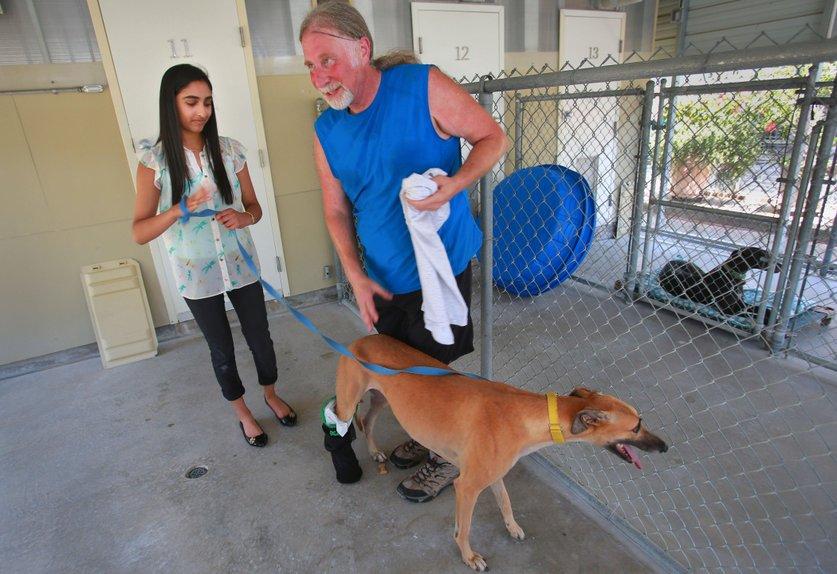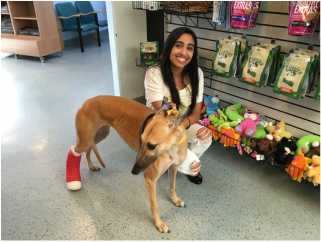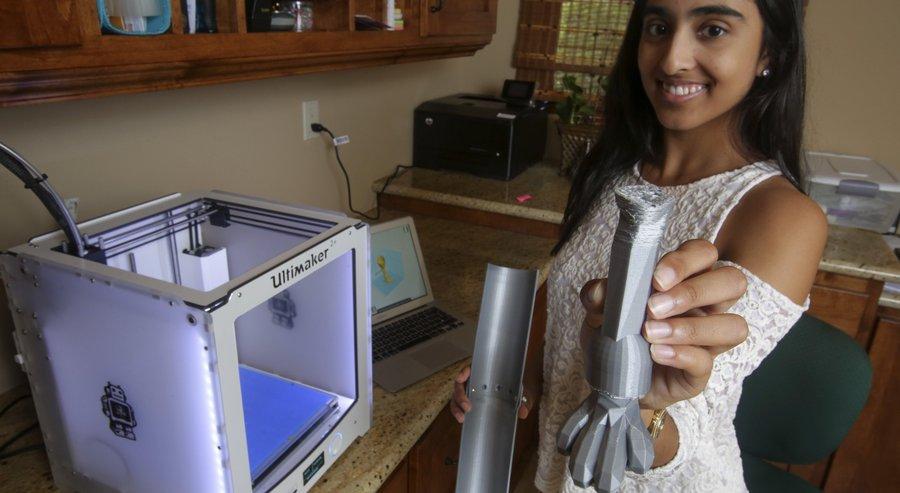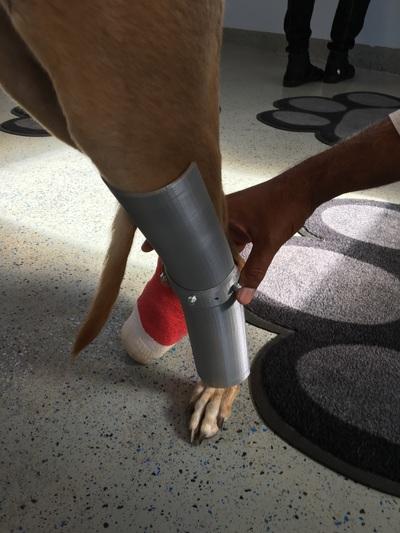Krishnan always loved animals and wanted a pet of her own – so much so that as an eight-year-old, she even made a PowerPoint presentation to her parents to try to convince them of why she should have a pet. She wasn’t successful in that particular mission, but her love of animals remained strong, and in 2009, during a visit to India to see relatives, she saw a number of injured stray dogs supporting themselves on only three legs.
Although she wanted to help the dogs, she didn’t know what she could do. The thought of the injured dogs has stayed with her for since then, though, and last year, she had an epiphany when she discovered that the library near her school had a 3D printing lab. The technology would be perfect for creating devices to help three-legged-dogs and other animals, she thought.
Although her parents had nixed the idea of getting a pet, they were fully supportive of their daughter’s idea to help injured animals. They weren’t surprised, either, when she began teaching herself about 3D printing.
Krishnan’s parents bought her an Ultimaker 3D printer to learn on, and she asked Jim Bixby, retired engineer, former CEO of SeQual Technologies (now Chart Industries), and current volunteer in the library’s 3D printing lab, to teach her how to design in CAD.“She was always fascinated with technology from an early age,” said her mother, Anitha Krishnan. “Her dad had an old typewriter that she was always tinkering with as a little girl.”
“I’m blown away by her,” said Bixby. “I couldn’t believe she’s a 10th-grader. She’s mature, self assured and super bright. I’ve coached lots of people in my career and she’s one of the most coachable I’ve come across. She listens to what you have to say, then goes off and when she comes back, she’s mastered it.”
Once she had learned the skills of 3D design and printing, Krishnan, with the help of her father, health care services executive Sri Gopal, set up a nonprofit she named Creature Comfort & Care. The plan was to design and fit 3D printed prostheses and splints to injured animals, free of charge. She began advertising her services to dozens of animal care services in the area, and although she didn’t get any responses at first, her parents advised her not to give up. Her breakthrough came with Darren Rigg, founder and president of the Greyhound Adoption Center, learned about what she was doing.

Krishnan at the Greyhound Adoption Center with volunteer Alan Landau and Leah the greyhound, who Krishnan fitted with a prosthetic leg. [Image: Peggy Peattie]
The Greyhound Adoption Center, and organizations like it, have saved thousands of lives by rescuing greyhounds, treating their injuries if necessary, and finding homes for them. Some of the most common injuries Rigg sees are broken legs, which are typically splinted with heavy casts that can cause further discomfort and difficulty for the fine-boned dogs. When he heard about Krishnan’s lightweight, custom-made 3D printed splints, he wanted to learn more.
Krishnan has now designed and printed splints for two dogs at the center, and is working on a set of 10 custom two-part splints that can be adjusted to fit the legs of nearly any size of dog. Her services don’t stop at dogs, either. Since word of her company spread, she has acquired additional clients, including the Living Coast Discovery Center, home to a Cooper’s hawk with a paralyzed leg. She is currently working on the third prototype of a prosthetic boot for the bird.“At first I thought it was probably a long shot, but the more contact we had with Nikita, the more we realized how incredibly clever she was, what a great attitude she has and what a great idea she came up with,” Rigg said.
She’s also working with the San Diego Zoo Institute for Conservation Research; David O’Connor, a coordinator for the institute, is part of the advisory board for Creature Comfort & Care, and he gave Krishnan the idea for her next project, a bird feeder that prevents the introduction of bacteria into the food supply. In one year, Krishnan’s startup has gone from an idea to a thriving business.
Since it only costs a dollar or two to produce a 3D printed splint, money isn’t a concern, so Krishnan can continue providing care for free – her only concern is time, as she balances her work with school, tennis and piano lessons. For help, she has enlisted her younger sister Sarina, who now serves as the organization’s vice president. Krishnan plans to keep Creature Comfort & Care running when she goes to college, where she hopes to pursue medicine or engineering.
Krishnan is the latest example of some incredible entrepreneurship shown by kids and teens with 3D printers. When I was 16, I was mostly writing terrible poetry and moping around the house; Krishnan is saving lives as the president of an IRS-approved nonprofit. There have always been young people with big ideas, drive and ambition, but 3D printing and other technology are making it easier for them to make those big ideas into reality. I can only imagine what else Krishnan and others like her will go on to accomplish. Kids with minds and hearts like hers certainly make the future seem brighter. Discuss further in the 3D Printed Prosthetics for Animals forum over at 3DPB.com.
[Sources: San Diego Union-Tribune / Creature Comfort & Care]Subscribe to Our Email Newsletter
Stay up-to-date on all the latest news from the 3D printing industry and receive information and offers from third party vendors.
You May Also Like
Further Understanding of 3D Printing Design at ADDITIV Design World
ADDITIV is back once again! This time, the virtual platform for additive manufacturing will be holding the first-ever edition of ADDITIV Design World on May 23rd from 9:00 AM –...
3D Printer Maker EVO-tech Reborn as NEVO3D — Once More With Feeling
EVO-tech was a 3D printing service and original equipment manufacturer established in 2013 and based in Schörfling am Attersee, Austria. The company produced high-quality material extrusion systems featuring linear bearings,...
3D Systems Brings 3D Printed PEEK Cranial Implant to the U.S. with FDA Clearance
For more than 10 years, 3D Systems (NYSE:DDD) has worked hand-in-hand with surgeons to plan over 150,000 patient-specific cases, and develop more than two million instruments and implants from its...
CDFAM Returns to Berlin for Second Annual Symposium
The second CDFAM Computational Design Symposium is scheduled for May 7-8, 2024, in Berlin, and will convene leading experts in computational design across all scales. Building upon the first event...


































